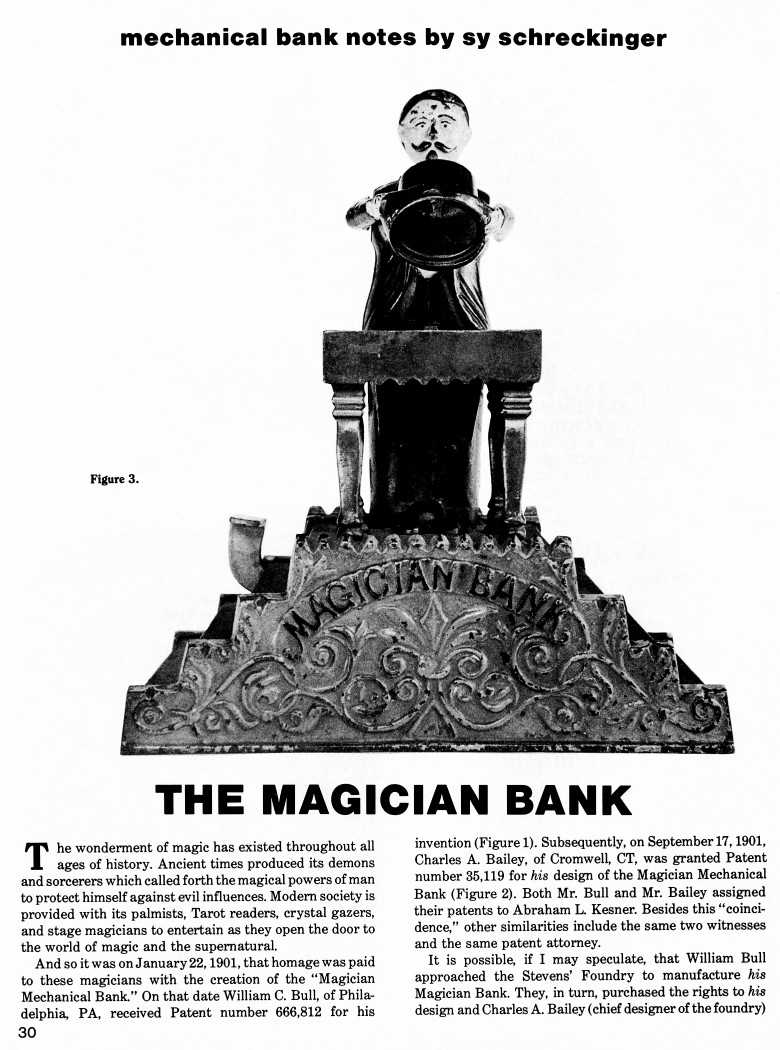|
The Magician Bank
by Sy Schreckinger – ANTIQUE TOY WORLD Magazine – February,
1985
The wonderment of magic has existed throughout
all ages of history. Ancient times produced its demons and sorcerers which
called forth the magical powers of man to protect himself against evil
influences. Modern society is provided with its palmists, Tarot readers,
crystal gazers, and stage magicians to entertain as they open the door to
the world of magic and the supernatural.
And so it was on January 22, 1901, that homage was paid to these
magicians with the creation of the "Magician Mechanical Bank." On that
date William C. Bull, of Philadelphia, PA, received Patent number
666,612
for his invention (Figure 1). Subsequently, on September 17, 1901, Charles
A. Bailey, of Cromwell, CT, was granted Patent number
35,119 for his
design of the Magician Mechanical Bank (Figure 2). Both Mr. Bull and Mr.
Bailey assigned their patents to Abraham L. Kesner. Besides this
"coincidence," other similarities include the same two witnesses and the
same patent attorney.
It is possible, if I may speculate, that William Bull approached the
Stevens' Foundry to manufacture his Magician Bank. They, in turn,
purchased the rights to his design and Charles A. Bailey (chief designer
of the foundry) planned and executed a simpler and more "esthetically"
pleasing bank. Bailey then patented his "improved" design. The final
production Magician Bank was manufactured by the Stevens' Foundry of
Cromwell, Connecticut.
The William C. Bull design (Figure 1) displays a somewhat more
complex action than the Charles A. Bailey design (Figure 2). The former
has both arms moving independently, while the latter has both arms
attached to the hat and moving as a single unit. Both patents utilized a
similar trap door and chute design within the table top, for the
disappearing coin illusion.
The action of the Magician Bank is uncomplicated and impressive. A
coin is placed within the circular design on the center of the table. The
lever (Figure 3) is then pressed. Simultaneously, as the Magician lowers
his hat to cover the coin, the small hinged trap door opens and the coin
drops through the chute under the table into the base of the bank. As the
lever is released, the Magician raises his hat, and, voila! the coin has
mysteriously disappeared. These coins are retrieved by way of a round
Stevens-type coin trap underneath the base of the bank.
To the best of my knowledge, there are no casting variations of the
Magician Bank, but there are several color variations. These include the
magician's hands and face – which maybe painted either white or a pink
flesh color – the steps leading up to the platform – which may be painted
with a textured flock paint in either chartreuse, fuchsia, or blue. (A
word of caution: A Magician bank with steps that are not coated with the
flocked paint most likely has been repainted.) The magician's hair,
mustache, beard, eyes, and eyebrows are always painted black, as are his
bow tie, hat, coat, trousers, and shoes. The wand in his right hand is
painted gold. The table is red with gold-trimmed legs. The front and back
of the base of the bank are painted turquoise-blue with black letters. The
lever is yellow, as is the saw-tooth design on the top edges of the base.
The Magician Mechanical Bank is extremely attractive and
entertaining, which may help to explain why it is highly sought after by
today's collector. Unfortunately, these attributes have contributed to the
poor condition in which this bank is generally found, since it was handled
and played with a great deal by those children for whom it had originally
been purchased and who discovered it to be an intriguing plaything. A
superb specimen will command a premium price. At a recent auction, a fine
Magician Bank sold for more than a three thousand percent increase above
its original selling price (95c in 1913), as shown in a copy of an
advertisement by the Fair Company of Chicago, Illinois (Figure 4).
There are several reproductions of the Magician Bank. Figure 5
indicates a base diagram of the original. A reproduction will appear
approximately one-eighth of an inch shorter in length than the original.
|


